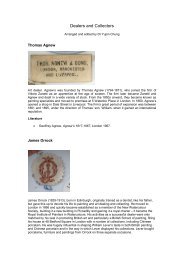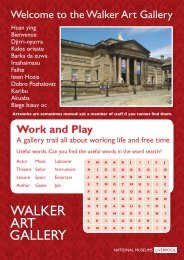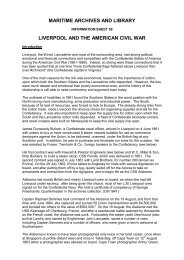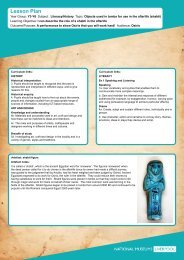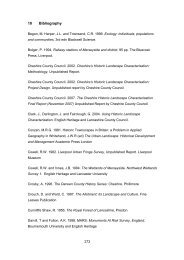Frank Partridge and William Hesketh Lever - National Museums ...
Frank Partridge and William Hesketh Lever - National Museums ...
Frank Partridge and William Hesketh Lever - National Museums ...
Create successful ePaper yourself
Turn your PDF publications into a flip-book with our unique Google optimized e-Paper software.
<strong>Frank</strong> <strong>Partridge</strong> <strong>and</strong> <strong>William</strong> <strong>Hesketh</strong> <strong>Lever</strong>Dr Yupin ChungDepartment of History of Art, University of GlasgowA Narrow EscapeAn old Chinese proverb says, ‘Good luck comes after the survival of a terribledisaster.’ This happened to <strong>Frank</strong> <strong>Partridge</strong>, 42, art dealer of 26 King Street,London <strong>and</strong> 741 Fifth Avenue, New York. On 1 May 1915 the Lusitania sailed outof New York <strong>and</strong> was torpedoed on the 7 th by a German submarine U20 off theOld Head of Kinsale, Irel<strong>and</strong>. The ship sank within 18 minutes. From 1,959passengers <strong>and</strong> crew, <strong>Partridge</strong> was one of the 761 survivors. 1 This dramaticscene was recorded in his memoirs, ‘The return I expected to be a lonelyjourney, so it was with pleasure that I accepted the invitation of eight dealerfriends I met in New York, who asked me to make up a party with them on theship they were taking back to Engl<strong>and</strong>. It seemed as if the voyage would be moreentertaining than I had originally thought. I was wrong. The ship we had chosenwas the Lusitania. I was the only member of our party rescued when the shipwent down.’ 2The news report of <strong>Frank</strong> <strong>Partridge</strong>'s narrow escape from the ‘improbable event’described it as like a miracle <strong>and</strong> attracted Sir <strong>William</strong> <strong>Hesketh</strong> <strong>Lever</strong>’s 3 attention.On 12 May 1915, five days after the tragedy, <strong>Partridge</strong> wrote to <strong>Lever</strong>: ‘It isindeed kind of you <strong>and</strong> your letter cheered us up. While I thank God for havingspared me my heart aches for those dear souls that have gone down.’ 4 One ofthose was Edgar Ezekiel Gorer (18721915), a renowned international dealer ofChinese art. Having survived the terrible disaster, <strong>Frank</strong> <strong>Partridge</strong> furtherstepped into the Chinese art market, took Gorer’s leading role, <strong>and</strong> became aregular dealer of Chinese works of art to Sir <strong>William</strong> <strong>Lever</strong>.When young <strong>Partridge</strong> met the Soap King<strong>Frank</strong> <strong>Partridge</strong> (18751953) was born in Hertford <strong>and</strong> grew up in a family of tenchildren, of which he was the ninth (Fig.1). 5 His father Robert, a bootmaker withan excellent reputation for his craftsmanship, enlarged the small shop over theyears <strong>and</strong> added departments for the sale <strong>and</strong> repair of readymade shoes. He1The Lusitania Resource: http://www.rmslusitania.info/pages/saloon_class/index.html#P2G. B. Spencer, The Memoirs of the Late <strong>Frank</strong> <strong>Partridge</strong>, Essex, 1961, p. 34. <strong>Partridge</strong>’swife used to go with him to New York. Fortunately, she decided to stay in London <strong>and</strong> helped inwelfare work. <strong>Partridge</strong>’s family were waiting for him at home.3<strong>William</strong> <strong>Hesketh</strong> <strong>Lever</strong> was created a baronet in 1911 <strong>and</strong> became Sir <strong>William</strong> <strong>Lever</strong>.4Letter from <strong>Frank</strong> <strong>Partridge</strong> to <strong>William</strong> <strong>Hesketh</strong> <strong>Lever</strong>, 12 May, 1915, <strong>Partridge</strong> Papers,Lady <strong>Lever</strong> Art Gallery (LLAG) Archives, 17.4/A. <strong>Partridge</strong> 3959, hereafter cited as <strong>Partridge</strong>Papers. Five boxes are labelled: 17.4/A (190415), 17.4/B (191517), 17.4/C (191719), 17.4/D(191922) <strong>and</strong> 17.4/E (192226).5According to published sources: The Times, Obituary, 11 August 1953, p.8 <strong>and</strong> 13August 1953, p.8. G. B. Spencer, The Memoirs of the Late <strong>Frank</strong> <strong>Partridge</strong>, Essex, 1961. UK1881 Census Online. CARP: http://www.hatii.arts.gla.ac.uk/admn/php/carp/index.php1
died when <strong>Frank</strong> was six. <strong>Frank</strong>’s eldest brother, Robert, 21, kept the shoebusiness going, but after two busy years he decided to go to Australia to try hisfortunes there. The eldest sister Emily decided to continue the business. Inspiredby her customers’ taste or her female intuition, she added an antique departmentnext to the big front window where she displayed the boots <strong>and</strong> shoes. In a smallglass case she kept a changing array of small antique china <strong>and</strong> jewellerypieces.Fig 1. <strong>Frank</strong> <strong>Partridge</strong> as a young man. © <strong>Partridge</strong> Fine Art Ltd.<strong>Frank</strong> was now about eight <strong>and</strong>, leaving his small private school, he might havebeen impressed by his sister’s business idea. However in 1883 <strong>Frank</strong>’s mother,Eliza, sent him to the London Orphans’ Academy at Watford. Would the highexpense of a private education pay off? He stayed for six years until he was 14years old <strong>and</strong> later recalled: ‘To me practice of knowledge is as essential as aknowledge of practice if a theory is to be understood <strong>and</strong> a job done well. Toemphasise theoretical knowledge to the exclusion of practice, as they did atWatford, seemed to me to be useless. Something of each I thought to berequired, a little theory <strong>and</strong> a lot of practice through which to thoroughly learn thetheory.’ 6In 1889 Robert returned from Australia after six years. He had tried many jobs,but none had satisfied him as he had hoped they would. He met Doris Cohenwho was the daughter of two London dealers <strong>and</strong> she introduced him to herfamily’s shop where Robert learnt about antiques. Shortly after they were6G. B. Spencer, 1961, p.p.1213.2
married, Robert <strong>and</strong> Doris took a small shop in Great Portl<strong>and</strong> Street, where theyquickly attracted attention through the fine quality of their goods. Dorisunderstood the way the markets went much better than Robert did, because shehad made contacts in the trade through her parents. Robert was serving a formof apprenticeship, first with the Cohen family, <strong>and</strong> then with his wife.Looking for a job with a ‘knowledge of practice’, <strong>Frank</strong> joined Robert around18911892. In his memoirs he noted, ‘I had to work hard with Robert. … Frommorning to night I was kept busy in the shop <strong>and</strong> in the storeroom, brushing theshelves, fetching trays, carrying exhibits <strong>and</strong> lifting <strong>and</strong> shifting cases of china,which Doris had managed to buy cheaply at one of the sales.’ 7‘One important aspect of antiques which I was fortunate enough to discover rightat the beginning is that their genuineness can always be ascertained by he whohas a real knowledge of the colours used on the originals, by the first craftsmen.It is a knowledge which can be acquired through personal experience, <strong>and</strong> notthrough theory; through one’s own eyes <strong>and</strong> not by the books of others.’ 8After the youngest brother, Leonard, came to join Robert’s business, <strong>Frank</strong> hadsome time to get out <strong>and</strong> see London <strong>and</strong> to experience himself as a ‘youngblooded dealer’. The most vivid memory he later described was going to theCaledonian ‘Cattle Market’ 9 with his brother <strong>and</strong> trying to sell things there, butwithout financial success. In 1893 <strong>Frank</strong> was offered a job by an American dealerfrom Chicago who came one day to Robert’s shop <strong>and</strong> asked him if he wasinterested in a new career. The Chicago of 1893 was a city of superlatives. 10 Ithosted the 1893 World’s Columbian Exposition, which was much bigger thanLondon’s Crystal Palace Exhibition of 1851, <strong>and</strong> even bigger than the 1889 ParisExposition. Encouraged by Robert, <strong>Frank</strong> decided to go to Chicago to make hisAmerican dream come true <strong>and</strong> was happy to accept the conditions: ten dollars aweek <strong>and</strong> free board.Unfortunately the dream soon turned into bitter reality. <strong>Frank</strong> didn’t get paid aspromised, <strong>and</strong> sadly he had to leave the shop, trying to survive in several jobssuch as polishing furniture for an Italian <strong>and</strong> performing as ‘Engl<strong>and</strong>’s LeadingComedian’ for one night in a local theatre. He convinced a German antiquesdealer of his skills <strong>and</strong> reliability by cleaning his horses <strong>and</strong> worked in his shopfor a while, but when <strong>Frank</strong>’s sister sent some money for the passage home heleft America. Emily was waiting for him in Liverpool. ‘I would not be seeking out apark bench to rest on, but that instead I would be going to sleep in the bed I had7G. B. Spencer, 1961, p.19.8G. B. Spencer, 1961, p.19.9In the early 20th century, as the trade in live animals diminished, a bricabrac marketdeveloped which after the Second World War transferred south of the river becoming the NewCaledonian or Bermondsey Market. The markets finally closed in 1963.10C. M. Rosenberg, America at the Fair: Chicago’s 1893 World’s Columbian Exposition, p.62.3
always known.’ Young <strong>Frank</strong> <strong>Partridge</strong> started working again with Robert <strong>and</strong>Doris, but he had sworn one day to be a dealer himself.Fig.2. <strong>Frank</strong> <strong>Partridge</strong>’s first business card. It reads, "<strong>Frank</strong> <strong>Partridge</strong>, Dealer in Works of Art, 4King Street, St James's, London, SW. Valuations Made. Collections Purchased.<strong>Frank</strong>, who was now 19 years of age, met Minnie, who became his wife in 1894.They both worked for Robert <strong>and</strong> Doris until Leo, their eldest son, was about six.They decided to take the plunge <strong>and</strong> started their own business in 1900. Theirpremises consisted of a small shop in 4 King Street, St. James (Fig.2), anexcellent area with Christie’s auction house just a stone’s throw away, but theyhad to put some of their own furniture in the shop to make it look full <strong>and</strong>impressive.Two days after the opening, the first customer to open the door was <strong>William</strong><strong>Lever</strong>, later Lord <strong>Lever</strong>hulme (18511925). 11 (Fig. 3) He started the conversationby asking, ‘What is the price?’<strong>Partridge</strong>: ‘It is X.’Mr. <strong>Lever</strong>: ‘It is very reasonable! I haven’t seen you before. You must benew here.’<strong>Partridge</strong>: ‘You don’t remember seeing us when you were in my brother’sshop – 19 St. James Street? 12 We have just opened two days ago but arerisking everything. We have the knowledge, experience <strong>and</strong>underst<strong>and</strong>ing required to make a success of antique dealing, but not thecash.’Mr. <strong>Lever</strong>: ‘You must continue. Work hard.’<strong>Partridge</strong>: ‘Would you like to be my sleeping partner?’Mr. <strong>Lever</strong>: ‘I will let you know tomorrow morning.’ 1311G. B. Spencer, p. 29.12<strong>Partridge</strong> may have met <strong>Lever</strong> at his brother’s shop, though <strong>Lever</strong>’s only recordedpurchase from R. W. <strong>Partridge</strong>, 19 St. James Street, occurred on 7 th May 1903.13G. B. Spencer, p.30.4
The next morning, <strong>Lever</strong> came back at the promised time. As a forthright man, hecame straight to the point: ‘I will not become your sleeping partner. If I join you, itwould discredit you with your other customers. Once they discover that I ambehind you they would assume I was taking the first choice of all you have, <strong>and</strong>so lose interest in coming to you.’ 14Fig.3. Portrait of <strong>William</strong> <strong>Hesketh</strong> <strong>Lever</strong> (1897), by Samuel Luke Fildes (18431927). Mr. <strong>William</strong><strong>Lever</strong> is shown as a prosperous <strong>and</strong> confident business man. (LL 3114)He then added: ‘A customer likes to imagine he is exploring virgin ground. Takeaway this belief <strong>and</strong> his interest is half gone. However, I will look after you asmuch as I can without taking up the position of a sleeping partner.’ <strong>Frank</strong><strong>Partridge</strong> expressed his gratitude for <strong>Lever</strong>’s financial assistance.Mr. <strong>Lever</strong> continued: ‘What can you get for me?’<strong>Partridge</strong>: ‘There will be a large sale tomorrow. I wanted to attend buthave reluctantly decided not to do so because of my shortage of capital.’<strong>Lever</strong> put his h<strong>and</strong> on his shoulder <strong>and</strong> said, ‘Go ahead <strong>and</strong> buy’. 15<strong>Partridge</strong> attended the sale <strong>and</strong> bought goods to the sum of £1,500, uponwhich Mr. <strong>Lever</strong> commented: ‘I liked it so much I bought the lot’ <strong>and</strong>recommended the new shop to his friends.14<strong>Lever</strong>’s considered views on copartnership; see his book, The SixHour Day <strong>and</strong> otherIndustrial Questions, reprinted by George Allen <strong>and</strong> Unwin Ltd., London, 1919, p.125.15G. B. Spencer, p.30.5
Fig.4. A view of <strong>Frank</strong> <strong>Partridge</strong>’s shop in 26 King Street taken on 14 Feb.1928. © <strong>Partridge</strong> FineArt Ltd.<strong>Partridge</strong> learnt a lesson from this man who, in his 40s, was worth millions, butwho had started as a grocer’s assistant with nothing in his pocket. As a result ofthe success <strong>and</strong> expansion of the new business, <strong>Partridge</strong> was eventually able tomove to 26 King Street in 1912 (Fig.4 <strong>and</strong> Fig.5).Fig.5. Interior of the 26 King Street shop. This view was taken in the 1920s. © <strong>Partridge</strong> Fine ArtLtd.Mr. Negotiator for <strong>Lever</strong>: ‘the collection that collected itself’The growth of <strong>Partridge</strong>’s confidence was based on purchasing at auctions onbehalf of customers such as <strong>Lever</strong>, as well as having a fine selection of antiquesin his shop. His talent in negotiating with other collectors for <strong>Lever</strong> was shown in1910. A letter from <strong>Partridge</strong> to <strong>Lever</strong> on 14 February records his exp<strong>and</strong>ingtrade after he had returned from America, where he opened up businesspremises at 741 Fifth Avenue, New York. He wrote, ‘I have a Client who wishes6
to get him some Black Chinese porcelain <strong>and</strong> if you have any that you are willingto dispose of I can get you good prices.’ 16 The following day <strong>Lever</strong> wryly replied,‘… I should not be willing to dispose of my black Chinese vases except at suchextreme prices as I feel confident would make you unwilling to entertain thepurchase.’ 17 <strong>Partridge</strong> thought that he was smart enough to negotiate, ‘I havebeen up to see your Black Vases <strong>and</strong> I shall be much obliged if you will let meknow your lowest price for the 5.’ 18 <strong>Lever</strong> showed his position as a seriouscollector of Chinese porcelain <strong>and</strong> wrote, ‘… I am not anxious to sell the Vases. Itis not possible for me to put them on offer’. He suggested, ‘If, however, you liketo make an offer you are at liberty to do so. I may say, however, that there are sixBlack Vases you evidently did not see the Large Oviform Vase of Red Hawthorn(Fig.6: LL 6731) in the China Corridor.’ 19Fig 6. Large oviform vase of red hawthorn (LL6731)<strong>Partridge</strong> created a reputation for <strong>Lever</strong> of being a celebrity collector of ChineseArt. For example, <strong>Lever</strong>’s popular view of China was expressed in TheConnoisseur, 1910, <strong>and</strong> highly praised by a female journalist WilloughbyHodgson. 20 <strong>Partridge</strong>’s strategy was to inveigle traders to spend their profits onamassing private hoards of treasures. It is interesting to speculate whether <strong>Lever</strong>was aware of <strong>Partridge</strong>’s ability for negotiating between top collectors or not; for it16<strong>Partridge</strong> to <strong>Lever</strong>, 14 February, 1910, <strong>Partridge</strong> Papers.17<strong>Lever</strong> to <strong>Partridge</strong>, 15 February, 1910, <strong>Partridge</strong> Papers.18<strong>Partridge</strong> to <strong>Lever</strong>, 18 February, 1910, <strong>Partridge</strong> Papers.19<strong>Lever</strong> to <strong>Partridge</strong>, 19 February, 1910, <strong>Partridge</strong> Papers.20‘Chinese Porcelain: Mr. <strong>William</strong> <strong>Hesketh</strong> <strong>Lever</strong>’s Collection of Chinese Porcelain’, TheConnoisseur, A Magazine for Collectors, Vol. XXVIII, No.112, December, 1910, p.p.22426.7
Fig 7. Kangxi oviform jar (LL6750)Dealercollector relations, 19151924A shift away from traditional forms of patronage (i.e. ceramics made to specialorder) to the public sale of works by aristocratic collectors to the members of theaffluent middle classes may help to account for the rise of the commercial artdealer in the late 19 th <strong>and</strong> early 20 th century. Chinese art dealing remained anunregulated market—visàvis other occupations or the selling of financialinstruments— such that art dealers were probably selfselected. Dealersbehaved as entrepreneurs, <strong>and</strong> their selfpromotion <strong>and</strong> innovation wereimportant in becoming successful market agents. 29<strong>Partridge</strong> was not from a privileged background which had a source of privatewealth as a form of income. He seldom made direct acquisitions of art butoperated on a commission basis between collectors, <strong>and</strong> dutifully acted as<strong>Lever</strong>’s ‘personal advisor’ who supplemented <strong>Lever</strong>’s own taste. With the moneyhe used to ‘recruit’ <strong>Partridge</strong>, <strong>Lever</strong> gained cultural competence.29See Derrick Chong, Stakeholder Relationships in the Market for Contemporary Art, inIain Robertson Underst<strong>and</strong>ing International Art Market <strong>and</strong> Management, London: Routledge,2005, p. 94.9
Fig.8. Figure of a Chinese Deity (LL 61).<strong>Partridge</strong> would answer any questions about objects <strong>Lever</strong> requested; forexample, about the history of a ‘Chinese Deity on a dragon’s head.’ 30 <strong>Partridge</strong>wrote, ‘This figure represents the Chinese god of literature. … I bought it atChristie’s on the 29 th July’ 31 (Fig.8: LL 61). The figure of a Chinese Deity seemsto offer a gloss that glitters: <strong>Partridge</strong>’s explanation makes china appear a superbsymbolic product. The Chinese god of literature becomes the iconic souvenir of asnobbish approach of collecting – simply an object of decoration.Founded in 1766 by James Christie, Christie’s has been ‘a name <strong>and</strong> place thatspeaks of extraordinary art, unparalleled service <strong>and</strong> expertise, as well asinternational glamour’. 32 From 1915 to 1924 <strong>Partridge</strong> purchased distinguishedcollections at Christie’s for <strong>Lever</strong>; collections including those of JefferyWhitehead (1915), Sir Trevor Lawrence (1916), Alfred. W. Stiff (1916), S. E.Kennedy (1916, 1918), C. S. Holberton (1918), <strong>and</strong> Robert H. Benson (1924).<strong>Partridge</strong> impressed <strong>Lever</strong> with his success in getting real bargains when heobtained some Chinese objects on the fourth day of the Whitehead sale, 11August 1915. This purchase included three pieces of ‘Black China’ which made<strong>Lever</strong> most delighted: a deep bowl in a composite black background <strong>and</strong> a pair ofsquare bottles cost <strong>Lever</strong> just £44. 2s. 0d including commission fee (Fig.9: LL6734, Fig.10: LL 6735 & LL 6736). Other bargains were got at a smallscale30A. J. H. Howard to <strong>Partridge</strong>, 7 August, 1915, <strong>Partridge</strong> Papers. Howard was the Curatorof Hulme Hall Art Gallery.31<strong>Partridge</strong> to Howard, 9 August, 1915, <strong>Partridge</strong> Papers.32For further details see Christie’s: http://www.christies.com/about/company/10
auction sale of ‘A Lady of Title’s’ collection on 14 March 1916, where <strong>Partridge</strong>purchased Chinese crystal <strong>and</strong> hardstone carvings for <strong>Lever</strong>. 33Fig.9. A deep bowl (LL 6734).<strong>Partridge</strong> treated his counselling service for <strong>Lever</strong> with caution, ‘I wanted tospeak to you about a pair of important Chinese figures which the owner wishes tosell, but this matter will keep until I see you.’ 34 <strong>Partridge</strong> knew <strong>Lever</strong>’s passion forChinese blue <strong>and</strong> white vases but still courteously asked him to ‘call in the nexttime you are in this neighbourhood.’ 35 <strong>Partridge</strong>’s role in getting people to signthe contract was to be central to the success of the agreement.During the First World War <strong>Lever</strong>’s soap business was still growing, 36 but he wasvery sensitive about prices <strong>and</strong> wrote a letter in an irritable tone, ‘It is quiteevident that War prices at the moment are not prevailing, but I believe that priceswill come down very considerably this next year. We have not yet felt the realfinancial pinch of this War <strong>and</strong> people are becoming a little too optimistic. ... I amnot at all carried away by the present prices prevailing for works of Art. Of courseif all the works of Art are to go to America, America can pay any price but Ishould think even Americans will live up to their characteristic of not desiring topay too much.’ 3733<strong>Partridge</strong> to <strong>Lever</strong>, 16 March, 1916, <strong>Partridge</strong> Papers.34<strong>Partridge</strong> to <strong>Lever</strong>, 3 November, 1915, <strong>Partridge</strong> Papers.35<strong>Partridge</strong> to <strong>Lever</strong>, 3 March, 1916, <strong>Partridge</strong> Papers.36<strong>Lever</strong> was highly praised for his soap business. Mrs. <strong>Partridge</strong> (Minnie) to <strong>Lever</strong>, 17November 1915, <strong>Partridge</strong> Papers.37<strong>Lever</strong> to <strong>Partridge</strong>, 22 December, 1915, <strong>Partridge</strong> Papers.11
Fig.10. A pair of square bottles (LL 6735 <strong>and</strong> LL 6736).On Christmas Eve 1915 <strong>Partridge</strong> replied, ‘I fail to see where you have anycause to complain with what you have bought. 38 <strong>Lever</strong> explained, ‘… I am notcomplaining of 1915 <strong>and</strong> I am not complaining if the prices are high in 1916. I amlike Mark Twain who was asked to speak about Heaven or Hell as to which hepreferred, <strong>and</strong> he said he did not like to express any opinion as he had friends inboth places. Your ideas as a dealer are centred in the Heaven of high prices, <strong>and</strong>as one who has been a collector for many years I have no reason to say a wordagainst that point of view. Low prices may be Hl but I could be equally happythere in 1916 as I have been in 1915.’ 39As <strong>Lever</strong> predicted, prices of Chinese objects rose in 1916 <strong>and</strong> the objects onoffer seemed to become even better in quality. The first sale of that year was thecollection of Sir (James John) Trevor Lawrence at Christie’s on 29 May. The sonof Sir <strong>William</strong> Lawrence (17831867), SerjeantSurgeon to Queen Victoria <strong>and</strong>Louisa Lawrence (180355), a renowned orchid grower, Sir Trevor (18311913)was himself trained as a surgeon, before becoming an MP <strong>and</strong> eventuallyPresident of the Royal Horticultural Society. 40 He was a wellknown collector ofobjets d'art, particularly oriental, <strong>and</strong> especially Japanese art, western porcelain38<strong>Partridge</strong> to <strong>Lever</strong>, 24 December, 1915, <strong>Partridge</strong> Papers.39<strong>Lever</strong> to <strong>Partridge</strong>, 28 December, 1915, <strong>Partridge</strong> Papers.40Sir James John Trevor Lawrence was the son of Sir <strong>William</strong> Lawrence <strong>and</strong> LouisaSenior, the daughter of a successful Mayfair haberdasher who had bought a country estate,Broughton House, near Aylesbury, Buckinghamshire. See Wikipediahttp://en.wikipedia.org/wiki/Sir_Trevor_Lawrence,_2nd_Baronet12
<strong>and</strong> old lace. 41 Some items from his collection are now in the Victoria <strong>and</strong> Albert<strong>and</strong> other museums. <strong>Partridge</strong> reported to <strong>Lever</strong>, ‘… all the Oriental Porcelain ...in my h<strong>and</strong>s <strong>and</strong> you can rest assured I will do my very best for you.’ 42 After theauction <strong>Partridge</strong> wrote, ‘One or two of the lots which we liked fetched fabulousprices; this was caused by 2 rich men bidding against one another; on the otherh<strong>and</strong> most of the other lots realized about half of what I marked them. If I havespent too much money you must send me a wire in the morning <strong>and</strong> I will stop,but as I told you these opportunities do not come along very often <strong>and</strong> it is moneywell laid out.’ 43 <strong>Lever</strong> was engaged in an ambiguous purchase decision <strong>and</strong> didnot have adequate information; at the same time, the buying task was complex<strong>and</strong> repeat business was possible. From the Sir Trevor Lawrence sale <strong>Lever</strong>bought many examples of fine <strong>and</strong> rare imperial cloisonné enamels (Fig.11: LL5916) <strong>and</strong> widened the scope of his collection.Fig.11. Cloisonné incense burner with Qianlong mark (LL 5916).One month later, through <strong>Frank</strong> <strong>Partridge</strong>, <strong>Lever</strong> bought a series of fahua pieces(Fig.12: LL 6067) from the S. E. Kennedy Sale on 21 June 1916. <strong>Partridge</strong>described how difficult it was to get a piece. He <strong>and</strong> rival London art dealer JohnSparks 44 were bidding for the same lot 182 (Pair of Figure of Kylins): ‘I’m sorrythe Auctioneer did not see my bid <strong>and</strong> was knocked down for 42 gns, however41See Marcus B. Huish, Catalogue of the Collection of Japanese Works of Art formedbetween 1869 <strong>and</strong> 1894 by Sir Trevor Lawrence, Privately Printed, London, 1895.42<strong>Partridge</strong> to <strong>Lever</strong>, 29 May, 1916, <strong>Partridge</strong> Papers.43<strong>Partridge</strong> to <strong>Lever</strong>, 31 May, 1916, <strong>Partridge</strong> Papers.44Further information of John Sparks Ltd. CARP entryhttp://www.hatii.arts.gla.ac.uk/admn/php/carp/index.php13
Sparks had a Commission for it so we should not have got it … we were lucky toget anything at all at our prices.’ 45 <strong>Lever</strong> spent £1,351. 7s. 0d in total.Fig.12. Fahua vase of double gourd shape (LL 6067).Sydney Ernest Kennedy (18551933) was a senior partner in the family firm ofSydney Kennedy & Co., one of the largest dealers in the foreign railway market<strong>and</strong> a senior trustee of the London Stock Exchange. He sold most of hiscollection when he disposed of his town house in 1916. The Chinese porcelainswere sold over two days, 2122 June 1916 <strong>and</strong> the Catalogue was described asbeing 'innovative', including illustrations, <strong>and</strong> for the first time some in colour.Although consisting largely of late Ming <strong>and</strong> Kangxi period wares, the collectionwas considered significant at the time, some having been acquired form earliernotable collectors, such as Trapnell (Fig.13: LL 6495), Stuart (Fig.14: LL 6670),Gr<strong>and</strong>idier, Huth <strong>and</strong> Revelstoke. Kennedy’s label is recognised by a dolphin <strong>and</strong>SEK monogram on paper (Fig.15). 464546<strong>Partridge</strong> to <strong>Lever</strong>, 22 June, 1916, <strong>Partridge</strong> Papers.CARP entry http://www.hatii.arts.gla.ac.uk/admn/php/carp/index.php14
Fig.13. Black mirror vase (LL 6495).Nine months after the Kennedy sale, Sparks thought that <strong>Lever</strong> might still beinterested in buying one of the Ming figures <strong>and</strong> made an attempt: ‘Kennedygave the sum of £850 for the figure, but I am now able to offer you £700. Shouldthis piece not interest you, may I ask you to be so kind as to allow one of yoursecretaries to send me back the coloured illustration.’ 47 On 12 March <strong>Lever</strong>replied, ‘I do not think it is likely to be of interest to me, therefore, do not miss asale to anyone else by considering it is under offer to me.’ 48 However, on thesame day <strong>Lever</strong> also inquired of <strong>Partridge</strong>: ‘Do you know anything about thefigure?’ 49 A more competitive dynamic was presented in <strong>Partridge</strong>’s response: ‘Iwas prepared to give £400 for it. There has been some restoration done to thehead <strong>and</strong> I think the head has been off, but this could be gone into if youentertain it. I am in favour of purchasing this if it can be got at a reasonable price,as it is a very fine figure <strong>and</strong> brilliant in colour.’ 50 He added: ‘I often wonderedwhere this figure had gone as Christie’s deliberately told me it was sold, <strong>and</strong> itlooks as though it was run up <strong>and</strong> bought in.’ 51 This incident suggests that thebalance of negotiating power had now shifted. <strong>Partridge</strong> acted as a powerfuldealer who was able to blacklist Sparks who ‘threatened’ him in the china market.A year later S. E. Kennedy’s second sale was held on 21 March 1918: <strong>Lever</strong>obviously put his trust in <strong>Partridge</strong>. 52474849505152Sparks to <strong>Lever</strong>, 8 March, 1917, <strong>Partridge</strong> Papers.<strong>Lever</strong> to Sparks, 12 March, 1917, <strong>Partridge</strong> Papers.<strong>Lever</strong> to <strong>Partridge</strong>, 12 March, 1917, <strong>Partridge</strong> Papers.<strong>Partridge</strong> to <strong>Lever</strong>, 13 March, 1917, <strong>Partridge</strong> Papers.<strong>Partridge</strong> to <strong>Lever</strong>, 13 March, 1917, <strong>Partridge</strong> Papers.<strong>Partridge</strong> to <strong>Lever</strong>, 26 March, 1918, <strong>Partridge</strong> Papers.15
Fig.14. Famille verte bowl (LL 6670).In their letters <strong>Lever</strong> <strong>and</strong> <strong>Partridge</strong> often discussed the transformation ofaesthetic value into economic value <strong>and</strong> <strong>Partridge</strong> included marked lists ofinteresting lots for <strong>Lever</strong>. On 24 June 1918 he sent two catalogues of snuffbottles to <strong>Lever</strong> <strong>and</strong> suggested, ‘If you can spare £500 I believe we can getnearly all the best ones.’ 53 <strong>Lever</strong> was smart enough to reply, ‘I think if I go up to£300 … it will be a good start. I have generally done better when I have startedslowly. If, however, the prices were extremely low, then I would leave it to yourdiscretion.’ 54 <strong>Partridge</strong> reported to <strong>Lever</strong> that he had a most successful day <strong>and</strong>bought 155 pieces which cost £445. 15s. 0d. <strong>Partridge</strong> additionally commentedon their value: ‘They are average about £2. 10. 0d per piece, which isexceedingly cheap. If you cannot afford to take the lot I am quite willing to keephalf of them myself. I do not think such an opportunity will come along again, <strong>and</strong>as they were going so cheaply I took the opportunity of making a nice collection.They will cause you lots of pleasure when you have time to go into them.’ 55 Partof the pleasure of collecting lies in competition, <strong>and</strong> the successful acquisitionprovides full customer satisfaction. <strong>Lever</strong> immediately replied, ‘I enclose cheque£490. 6. 6 being the amount of the price paid at auction, plus 10%.’ 56 (Fig.16: LL9323)53545556<strong>Partridge</strong> to <strong>Lever</strong>, 24 June, 1918, <strong>Partridge</strong> Papers.<strong>Lever</strong> to <strong>Partridge</strong>, 24 June, 1918, <strong>Partridge</strong> Papers.<strong>Partridge</strong> to <strong>Lever</strong>, 26 June, 1918, <strong>Partridge</strong> Papers.<strong>Lever</strong> to <strong>Partridge</strong>, 27 June, 1918, <strong>Partridge</strong> Papers.16
Fig.15. S. E. Kennedy’s label.After the decision had been taken to build the Lady <strong>Lever</strong> Art Gallery in 1914,<strong>Lever</strong> bought some quite different Chinese objects (e.g. jade <strong>and</strong> hardstones,cloisonné enamels, <strong>and</strong> reverse paintings on glass) for his new gallery through<strong>Partridge</strong>. In 1918 <strong>Lever</strong> asked him to recommend a curator. 57 <strong>Partridge</strong>introduced a young collector, John H. Gardner who was from Witham, Essex: ‘Iwill endeavour to get Mr. Gardner’s porcelain for the £600. He seems quite a niceman <strong>and</strong> has a liking, <strong>and</strong> a slight knowledge of Works of Art. I should think hewould be a good man to have as a Curator as he has spent some time at theBritish Museum <strong>and</strong> the South Kensington Museum. If your Lordship still wants aman, I think it is worth while seeing him <strong>and</strong> taking up his references. He hasbeen a Captain in the Army <strong>and</strong> from the conversation I had with him I gather hewould like such a job as yours.’ 58 Unfortunately this deal was not successful.<strong>Lever</strong> said that he had no job for Gardner at this moment <strong>and</strong> he was not willingto buy his collection.’ 59 Perhaps the obligation became too compulsive for <strong>Lever</strong>.Once he wrote to <strong>Partridge</strong>: ‘I am still like the small boy who has spent hisSaturday penny on the previous Saturday <strong>and</strong> has on Monday to content himselfwith looking through the confectioners’ windows at the sweeties. I still getoccasional pleasure from looking through the windows, but I have no intention ofbuying for some time.’ 6057585960<strong>Partridge</strong> to <strong>Lever</strong>, 30 October, 1918, <strong>Partridge</strong> Papers.<strong>Partridge</strong> to <strong>Lever</strong>, 3 September, 1919, <strong>Partridge</strong> Papers.<strong>Partridge</strong> to <strong>Lever</strong>, 13 October, 1919, <strong>Partridge</strong> Papers.<strong>Lever</strong> to <strong>Partridge</strong>, 29 September, 1921, <strong>Partridge</strong> Papers.17
Fig.16. Example of a snuff bottle from the <strong>Lever</strong> collection (LL 9323).On 18 December 1922 <strong>Partridge</strong> was invited to the opening of the Lady <strong>Lever</strong> ArtGallery at Port Sunlight. The Museum was dedicated to the memory of <strong>Lever</strong>’swife Lady Elizabeth Ellen <strong>Lever</strong> who died in 1913. <strong>Partridge</strong> expressed hisadmiration for what <strong>Lever</strong> had achieved. He wrote, ‘I must confess a touch ofpride came to me at having had a good share in collecting some of them. ... mostimpressive sights are the Sculpture Halls <strong>and</strong> the Oriental Porcelain, which Ithought looked lovely.’ 61 <strong>Lever</strong> replied, ‘I am sorry I did not see you there, but itwas all such an exciting time <strong>and</strong> so rushed that it was impossible. I enclose youcopy of the speech from a Liverpool paper.’ 62 During the opening, <strong>Partridge</strong> wasvery sociable with <strong>Lever</strong>’s guests; the next day he wrote, ‘The Queen has askedme to help her in placing important pieces of furniture illustration in Mr.McQuoid’s Book. ... Your Lordship must have several of these pieces, <strong>and</strong> if youcould give me a list of them.’ 63In March 1923 a Chinese Australian merchant, Mr. <strong>William</strong> Yinson Lee 64 wasprobably introduced to <strong>Lever</strong>. He was a key member of the Rotary Club ofShanghai in the 1920s <strong>and</strong> wanted to sell his collection to <strong>Lever</strong>. However,<strong>Partridge</strong> acted as a monopolist in dealing with collectors <strong>and</strong> wrote, ‘I have justbeen to see Mr. <strong>William</strong> Yinson Lee’s Collection of Porcelain…. They are all very61<strong>Partridge</strong> to <strong>Lever</strong>, 18 December, 1922, <strong>Partridge</strong> Papers.62<strong>Lever</strong> to <strong>Partridge</strong>,19 December, 1922, <strong>Partridge</strong> Papers.63<strong>Partridge</strong> to <strong>Lever</strong>, 19 December, 1922, <strong>Partridge</strong> Papers.64Family photographs of Mr <strong>and</strong> Mrs <strong>William</strong> Yinson Lee, On Yik Lee & Co. in Sydney, canbe found in many files in the <strong>National</strong> Archives. http://www.naa.gov.au/whatson/online/showcases/chineseaustralians/yinsonlee.aspx18
inferior pieces.’ 65 <strong>Lever</strong> was very surprised about this rejection. 66 Some of YinsonLee’s pieces are now shown in the Powerhouse Museum, Australia. However,<strong>Partridge</strong> proposed from the ‘Tonying Collection’ 67 a ‘pair of puzzle teapots for£300’ 68 but <strong>Lever</strong> replied, ‘Not of interest to me.’ 69 It seems that <strong>Lever</strong> <strong>and</strong><strong>Partridge</strong> occasionally had different concepts of power play in the antiquesmarket.<strong>Lever</strong> argued, ‘… Cobden’s 70 definition of business was buying in the cheapestmarket <strong>and</strong> selling in the dearest. I have such confidence in your buying that I amcertain you fulfil the first requisite, <strong>and</strong> now that you have got a wider marketincluding the United States, it is quite obvious you are able to fill the second.’ 71The following day <strong>Partridge</strong> replied, ‘I am always anxious to offer you pieces thatI think suit your Lordship, in preference to any other Client. ... Thank you for thecompliment you paid me as regards ‘buying’ because one knows that if thebuying is wrong, the bottom falls out.’ 72<strong>Lever</strong>’s answer followed soon: ‘I do not like longst<strong>and</strong>ing friendships cooling offany more than I like ices this hot weather warming off. Let us keep the ices cold<strong>and</strong> the friendship warm, but I haven’t conscious now, <strong>and</strong> I should not havebeen your friend if I had not mentioned it, that … I am beginning to think that Mr.<strong>Frank</strong> <strong>Partridge</strong> must be described as an Art Dealer entirely surrounded bywealthy American customers <strong>and</strong> that the poor Englishman is frozen out.’ 73<strong>Partridge</strong> replied forthwith, ‘I promise you that it will not be through lack of desireon my part that our happy relationship should not be even more strongly united inthe future, <strong>and</strong> if the Englishman is frozen out it will not be the fault of yourssincerely.’ 74In 1923 the dealercollector relationship was already weatherproof <strong>and</strong> talkingabout success implied another meaning, ‘If your Lordship does not make muchmoney out of your work, you can comfort yourself with the satisfaction of knowingthat you do try <strong>and</strong> help keep the world clean.’ 7565<strong>William</strong> Yinson Lee’s list of antique Chinese porcelain contains 349 items. <strong>Partridge</strong> to<strong>Lever</strong>, 1 March, 1923, <strong>Partridge</strong> Papers.66<strong>Lever</strong> to <strong>Partridge</strong>, 2 March, 1923, <strong>Partridge</strong> Papers.67<strong>Partridge</strong> to <strong>Lever</strong>, 7 May, 1923, <strong>Partridge</strong> Papers. The Tonying Company wasestablished in Paris in 1902 by Zhang Renjie (18771950), also known as Zhang Jingjiang,millionaire financier, <strong>National</strong>ist Government official <strong>and</strong> patron of both Sun Yatsen <strong>and</strong> ChiangKaishek. Westerners dubbed him ‘Curio’ Zhang. Further information on the TonYing & Co., seeCARP entry. http://www.hatii.arts.gla.ac.uk/admn/php/carp/essay1.php?enum=109663857068<strong>Partridge</strong> to <strong>Lever</strong>, 10 May, 1923, <strong>Partridge</strong> Papers.69<strong>Lever</strong> to <strong>Partridge</strong>, 11 May, 1923, <strong>Partridge</strong> Papers.70Richard Cobden (18041865).71<strong>Lever</strong> to <strong>Partridge</strong>, 24 July, 1923, <strong>Partridge</strong> Papers.72<strong>Partridge</strong> to <strong>Lever</strong>, 25 July, 1923, <strong>Partridge</strong> Papers.73<strong>Lever</strong> to <strong>Partridge</strong>, 2 August, 1923, <strong>Partridge</strong> Papers.74<strong>Partridge</strong> to <strong>Lever</strong>, 3 August, 1923, <strong>Partridge</strong> Papers.75<strong>Partridge</strong> to <strong>Lever</strong>, 28 September, 1923, <strong>Partridge</strong> Papers.19
No ‘China’ business but friendship in the Last DaysIn a letter dated 23 March 1925 <strong>Partridge</strong> wrote to <strong>Lever</strong>, ‘[I] am sorry that thegathering on the 28 th May will not be able to have the pleasure of your Lordship’scompany. Thank you very much for your kind enquiries about my family <strong>and</strong> I amglad to say they are all in the best of health. There has been quite a lot doing inthe Art World since you have been away, but still there are some nice things left,<strong>and</strong> I hope I shall soon be seeing you.’ 76 This was followed by another letter thenext day, ‘Will you kindly accept the enclosed, which I know you will appreciate? Isaw it when I was dining with some friends in New York <strong>and</strong> I asked them to try<strong>and</strong> get me two copies – one of which I am keeping for my self, <strong>and</strong> trying to doit!’ 77<strong>Partridge</strong> had sent framed verses by E. A. Guest 78 <strong>and</strong> <strong>Lever</strong> replied, ‘I amdelighted to have them <strong>and</strong> can quite underst<strong>and</strong> your wishing to possess a copyyourself after seen them in New York…It is most generous of you to send me theother copy.’ 79Guest's most famous poem is the oftquoted ‘Home’.It don't make any difference how rich ye get t' be',How much yer chairs an’ tables cost, how great yer luxury;It ain't home t' ye, though it be the palace of a king,Until somehow yer soul is sort o' wrapped round everything.Home ain't a place that gold can buy or get up in a minute;Afore it's home there's got t' be a heap o' living in it.Excerpt from ‘Home’, A Heap o' Livin' (1916).76<strong>Partridge</strong> to <strong>Lever</strong>, 23 March, 1925, <strong>Partridge</strong> Papers.77<strong>Partridge</strong> to <strong>Lever</strong>, 24 March, 1925, <strong>Partridge</strong> Papers78Edgar Albert Guest (18811959) (aka Eddie Guest) was called ‘The Poet of the People’,‘Poet Laureate of the American Home’ <strong>and</strong> ‘America's Best Loved Poet of the Newspaper Age.’Guest penned some 11,000 poems which were syndicated in some 300 newspapers <strong>and</strong>collected in more than 20 books.79<strong>Lever</strong> to <strong>Partridge</strong>, 26 March, 1925, <strong>Partridge</strong> Papers. This is likely to be the last letter<strong>Lever</strong> wrote to <strong>Partridge</strong>. On his death, of pneumonia, on 7 May, 1925, the <strong>Lever</strong>hulmeviscountcy passed to his son <strong>William</strong> Hulme <strong>Lever</strong>.20


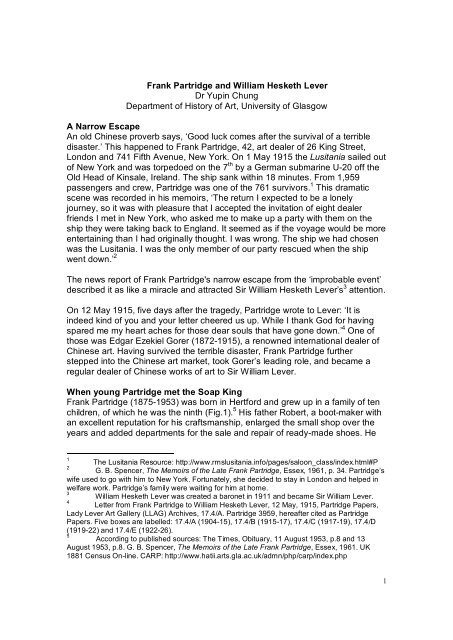
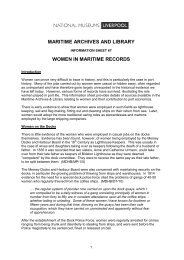
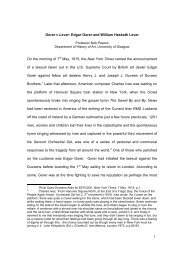
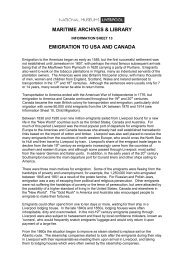
![Ancient Egypt trail [227kb .pdf] - National Museums Liverpool](https://img.yumpu.com/48998817/1/184x260/ancient-egypt-trail-227kb-pdf-national-museums-liverpool.jpg?quality=85)

